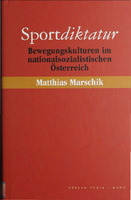Sportdiktatur
Bewegungskulturen im nationalsozialistischen Österreich
Author(s)
Marschik, Matthias
Collection
Austrian Science Fund (FWF)Language
GermanAbstract
The intention of the book is to reduce the enormous Austrian research deficiency concerning the reappraisal of the sporting life during the NS-era. Therefore it will depict all sportive areas on the "Austrian" territory between March 1938 and April 1945, including top sports and sports for all, mass and monority sports, sports in clubs, youth sports and also sports practices of the formations of the NSDAP. Due to the enormous quantity of material, this overview will be contrasted by a precise analysis of three specific periods: the months after the "Anschluss", the autumn 1939 and the period after Stalingrad.
It can be shown, that and how the regime dictated the basic conditions of sports, but there can also be found some grey area, in which those who were involved found resp. created freedom by strategies of mutual adaption. This freedom was used by different groups in specific ways: by the regime to calm down the working class or to soothe anti-prussian resentments, by the athletes to get some privileges and by the spectators to keep a glimpse of good luck. Not instrumentalization defined sports, but a negotiation of interests.
It is just gaze on the everyday life of sports and the inherent permanent negotioations between regime and the people, that refer to the book´s contribution to the long term discussion on national socialism, which exceeds the field of sports: The political and cultural system of the Nazi-era could not be understood by looking at power, competences or possibilities of the regime in comparison with the people´s experiences and feelings of subjection, from which historical sciences construct the image of an interlude, which cannot be included in the evolutionary development of modernity.
Looking on sports not only claryfies, to which extent cultural traditions led on and how "normality" was kept alive, but shows, in which ways changes and new valuations were obviously shared and use by the people. This concerned changing definitions of the sense of community, of gender, youth, work and performance. The special importance of sports can be found in substantiating these articulations by giving them authenticity and tracing them back to the nature of men.
The analysis of sporting life in the NS-era may serve as an cause for questioning the contemporarygaze on the Nazi state. For all people, who were allowed to be included, life in national socialism offered - in spite of holocaust and World War - supply of a pleasant, self-detemined and enjoyable livehood. Who leaves aside or overlooks this facet of the Nazi dictatorship, will not be able to understand the acceptance and fascination of the regime and evoke just this often senseless metaphors of refusal, which mostly shape actual discourses. Primäre Intention des Buches ist die Reduktion des enormen österreichischen Forschungsdefizit zur Aufarbeitung des Sportlebens unter dem NS-Regime. Daher wird der gesamte Bereich des Sportes im Territiorium Österreichs zwischen 1938 und 1945 dargestellt: Der Breiten- und Spitzensport, Massen- und Minderheitensport, den Vereins- und Jugendsport sowie der Sport der Formationen. Auf Grund der Materialfülle wird die Überblicksdarstellung von einer Detailanalyse zu drei Zeitpunkten begleitet: In den Monaten nach dem "Anschluss", rund um den Kriegsbeginn und in der Endphase des Regimes nach Stalingrad.
Es lässt sich zeigen, dass und wie das Regime die Rahmenbedingungen des Sportes diktierte, doch manifestiert sich zugleich eine Grauzone, in der die Beteiligten durch Strategien gegenseitiger Anpassung Freiräume vorfanden bzw. schufen, die in je spezifischer Weise genutzt wurden, vom Regime etwa zur Beruhigung der Arbeiterschaft oder zur Kalmierung anti-preußischer Ressentiments, von den Aktiven zur Erlangung von Begünstigungen und von den Zuschauern zur Erfüllung eines "kleinen Glücks".
Gerade die Betrachtung des alltäglichen Sportgeschehens und der darin ständig erneuerten Aushandlungen zwischen Regime und Bevölkerung verweisen auf den Beitrag des Buches zur NS-Dskussion, mit welchem das Terrain des Sportes überschritten wird: Das NS-System ist nicht aus dem Zusammenspiel verabsolutierter Macht, Kompetenzen und Möglichkeiten des Regimes mit Erfahrungen und Gefühlen des Ausgeliefertseins zu verstehen, aus dem die Geschichtsschreibung das Bild eines Intermezzos konstruiert, das nicht in den Ablauf der Moderne eingegliedert werden kann.
Die Betrachtung des Sportes verdeutlicht, wie sehr im NS-Staat "Normalität" aufrecht erhalten wurde, wie sehr zum anderen vom Regime intendierte Veränderungen von den Menschen mit getragen wurden. Das betrifft etwa Definitionen von Gemeinschaft, von Geschlecht, Jugend und Leistung. Diese Redefinitionen kultureller Felder waren nicht nur oktroyiert, sondern wurden von den "Volksgenossen" und "-genossinen" aufgegriffen und geteilt. Es war gerade der Sport, die diese Artikulationen bestätigte, indem er ihnen Authentizität verlieh und sie scheinbar an die menschliche Natur koppelte.
So kann die Analyse des Sportgeschehens im Nationalsozialismus dazu dienen, den aktuellen Blick auf den NS-Staat zu hinterfragen: Für alle, die dazu gehören durften, bot das Leben trotz Holocaust und Weltkrieg auch Angebote einer angenehmen, selbstbestimmten und vergnügten Existenz. Wer diese Seite der NS-Diktatur ausklammert, wird nicht imstande sein, die "Faszination" und/oder Akzeptanz dieses Regimes zu verstehen - und ruft damit bei den nachfolgenden Generationen jene weitgehend sinnleeren Metaphern der Ablehnung hervor, wie sie vielfach die aktuellen Diskurse zum Nationalsozialismus prägen.
Keywords
Sport; National Socialism; Popular Culture; Austria; Deutschland; Fußball; Hitlerjugend; Kraft durch Freude; NS-Staat; Österreich; Sturmabteilung; WienDOI
10.26530/oapen_574814ISBN
9783851325157OCN
1030818941Publisher
Turia und KantPublication date and place
2008Grantor
Classification
Society and Social Sciences


 Download
Download